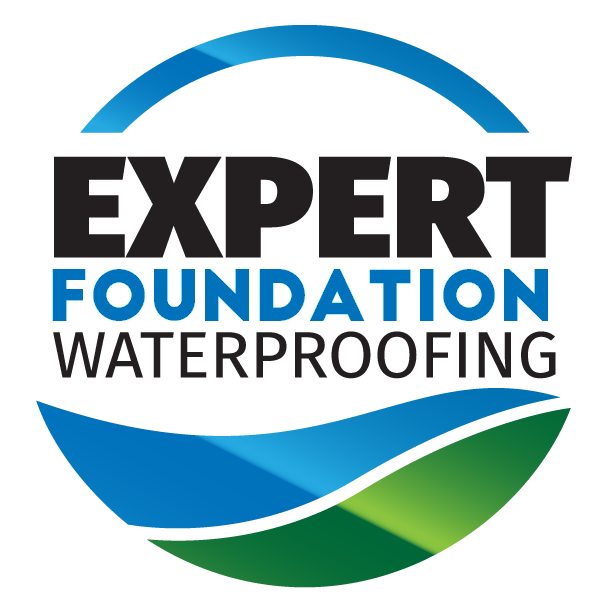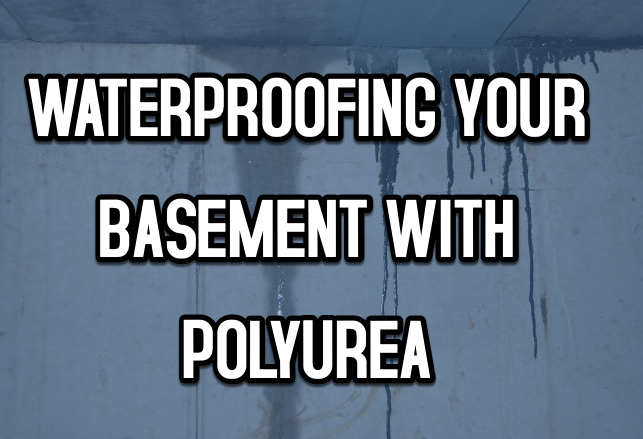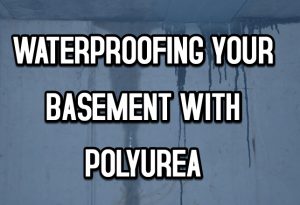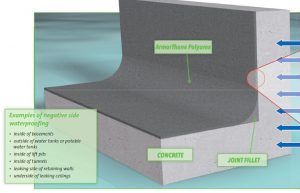It’s quite unpleasant to deal with even just a little dampness in your basement.
When that little leak or dampness becomes a bigger problem, or if your basement is leaking more water than just the little bit from the rain, it’s time for you to act.
However, you don’t have to run right away and look for a company specializing in waterproofing basements. The right industrial coating can make your basement waterproof. It’s important to find the right applicator. Rather than spending tens of thousands on a specialist, a reputable supplier of protective coatings could be the answer. Read on to learn more about Polyurea and what it can do for your leaky basement.
All basements are not created equal.
The type of basement walls will always play a role in how the basement leaks.
Poured concrete walls – These usually leak along the joint between the floor and the wall. High hydrostatic pressure outside the foundation can cause leakage into even the most solid concrete walls. It can also force water into the basement along the crack between the floor and the walls.
Also, any cracks that form in poured concrete walls are ideal pathways for water to enter the basement.
Concrete block walls – Like poured concrete walls, these will also leak along the floor/wall joint. The mortar joints between individual concrete blocks also have the potential to leak. If there’s pressure against a concrete block foundation, it can weaken the mortar joints. This causes cracks that allow for water seepage.
Also, the hollow cores in concrete slabs can fill with water which, in turn, will cause the foundation to leak.
Clay tile walls – These walls are sometimes found on historic houses, and the most common location for a leak is the floor/wall joint. The mortar joints between clay tiles are also a common place for seepage.
Similar to concrete blocks, clay tiles also have hollow cores that can become filled with water. This can create a reservoir of water that can leak into the basement over time.
It should be noted that clay tile is brittle and more easily damaged than other masonry materials, so extra care must be taken when working on this type of wall.
Basement waterproofing might seem daunting.
It might not be as difficult as you think. A polyurea coating can be your first-line defense against damp basements. It is easy to apply and takes only a few steps.
Prepare the surface.
This is the first step to ensure you get the best coating results. Before you begin any talks about waterproofing basements, make sure that you have read the label instructions.
Test the product in an area that isn’t visible. This will allow you to determine if the product has proper adhesion.
You must clean and dry the wall surface. You can sand any rough surfaces of wood and remove peeling or missing paint using a wire brush.
Sand Blast
You can prepare concrete surfaces by using a carborundum disc and a disc grinder.
Repair concrete that is crumbling or loose and let it cure.
You will need to power wash concrete if it has mildew. If it is new concrete, let it cure for at most 30 days before you apply a coating.
Prime the surface and fill in any cracks. Then, apply seam tape.
Fill any cracks or joints that are larger than 1/8 inches with a trowel-grade coating and filler. You will need to seam tape cracks and joints to prevent future cracking or leaking. You can shape it with your fingers by using contouring seam tape, which is self-adhesive and high-strength.
It is almost impossible to remove seam tape once it has been placed on a primed surface—Prime all surfaces before applying seam tape for best adhesion.
Do not use asphalt sealers in place of them. Asphalt sealers don’t waterproof. Asphalt floats on damp surfaces.
Before you start, make sure to cover sensitive areas.
It is required to dry the basement walls completely before you begin. A propane space heater can be used, or you can rent or buy a construction heater.
Allow for adequate ventilation once everything has drained. Damp basements cannot be waterproofed.
However, keep in mind that high humidity and low temperatures may result in a longer drying or curing period.
- Application – Regular and heavy duty
The ArmorThane polyurea coating will be applied. Follow the instructions carefully to ensure the correct mixing of the chemicals.
The coating should be applied until the surface is smooth and has a thickness of at least 30mil. This is about the thickness of one dime.
Two coats of waterproofing will be sufficient to cover all surfaces in your basement. However, it is better to have more. This is especially important if you have severe water leaking problems.
- Secure cleanup, storage, disposal
Water can be used to clean up small spillages and tools. You can store any unopened product in the original container. It should be kept at 45-85 degrees F.
If you are interested in finding out more about how you can purchase polyurea, give ArmorThane a call and they will be happy to assist you.




